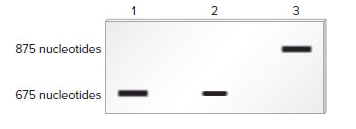
Concept explainers
Chapter 21 describes a technique known as Northern blotting that is used to detect RNA transcribed from a particular gene. In this method, a specific RNA is detected using a short segment of cloned DNA as a probe. The DNA probe, which is labeled, is complementary to the RNA that the researcher wishes to detect. After the probe DNA binds to the RNA, the RNA is run on a gel and then visualized as a labeled (dark) band. As shown here, the method of Northern blotting can be used to determine the amount of a particular RNA transcribed in a given cell type. If one type of cell produces twice as much of a particular mRNA as another type of cell does, the band will appear twice as intense. Also, the method can distinguish whether alternative RNA splicing has occurred to produce an RNA that has a different molecular mass.

Lane 1 is a sample of RNA isolated from nerve cells.
Lane 2 is a sample of RNA isolated from kidney cells. Nerve cells produce twice as much of this RNA as do kidney cells.
Lane 3 is a sample of RNA isolated from spleen cells. Spleen cells produce an alternatively spliced version of this RNA that is about 200 nucleotides longer than the RNA produced in nerve and kidney cells.
Let’s suppose a researcher is interested in the effects of mutations on the expression of a particular protein-encoding gene in eukaryotes. The gene has one intron that is 450 nucleotides long. After this intron is removed from the pre-mRNA, the mRNA transcript is 1100 nucleotides in length. Diploid somatic cells have two copies of this gene. Make a drawing that shows the expected results of a Northern blot using mRNA from the cytosol of somatic cells, which were obtained from the following individuals:
Lane 1: A normal individual
Lane 2: A homozygote for a deletion that removes the
Lane 3: A heterozygote in which one gene is normal and the other gene has a deletion that removes the
Lane 4: A homozygote for a mutation that introduces an early stop codon into the middle of the coding sequence of the gene Lane
5: A homozygote for a two-
Want to see the full answer?
Check out a sample textbook solution
Chapter 12 Solutions
GENETICS:ANALYSIS+PRIN.(LL)-W/ACCESS
- Plating 50 microliters of a sample diluted by a factor of 10-6 produced 91 colonies. What was the originalcell density (CFU/ml) in the sample?arrow_forwardEvery tutor here has got this wrong, don't copy off them.arrow_forwardSuppose that the population from question #1 (data is in table below) is experiencing inbreeding depression (F=.25) (and no longer experiencing natural selection). Calculate the new expected genotype frequencies (f) in this population after one round of inbreeding. Please round to 3 decimal places. Genotype Adh Adh Number of Flies 595 Adh Adh 310 Adhs Adhs 95 Total 1000 fladh Adh- flAdn Adh fAdhs Adharrow_forward
- Which of the following best describes why it is difficult to develop antiviral drugs? Explain why. A. antiviral drugs are very difficult to develop andhave no side effects B. viruses are difficult to target because they usethe host cell’s enzymes and ribosomes tometabolize and replicate C. viruses are too small to be targeted by drugs D. viral infections usually clear up on their ownwith no problemsarrow_forwardThis question has 3 parts (A, B, & C), and is under the subject of Nutrition. Thank you!arrow_forwardThey got this question wrong the 2 previous times I uploaded it here, please make sure it's correvct this time.arrow_forward
- This question has multiple parts (A, B & C), and under the subject of Nutrition. Thank you!arrow_forwardCalculate the CFU/ml of a urine sample if 138 E. coli colonies were counted on a Nutrient Agar Plate when0.5 mls were plated on the NA plate from a 10-9 dilution tube. You must highlight and express your answerin scientific notatioarrow_forwardDon't copy off the other answer if there is anyarrow_forward
 Human Heredity: Principles and Issues (MindTap Co...BiologyISBN:9781305251052Author:Michael CummingsPublisher:Cengage Learning
Human Heredity: Principles and Issues (MindTap Co...BiologyISBN:9781305251052Author:Michael CummingsPublisher:Cengage Learning Biology Today and Tomorrow without Physiology (Mi...BiologyISBN:9781305117396Author:Cecie Starr, Christine Evers, Lisa StarrPublisher:Cengage Learning
Biology Today and Tomorrow without Physiology (Mi...BiologyISBN:9781305117396Author:Cecie Starr, Christine Evers, Lisa StarrPublisher:Cengage Learning Human Biology (MindTap Course List)BiologyISBN:9781305112100Author:Cecie Starr, Beverly McMillanPublisher:Cengage Learning
Human Biology (MindTap Course List)BiologyISBN:9781305112100Author:Cecie Starr, Beverly McMillanPublisher:Cengage Learning- Case Studies In Health Information ManagementBiologyISBN:9781337676908Author:SCHNERINGPublisher:Cengage
 Concepts of BiologyBiologyISBN:9781938168116Author:Samantha Fowler, Rebecca Roush, James WisePublisher:OpenStax College
Concepts of BiologyBiologyISBN:9781938168116Author:Samantha Fowler, Rebecca Roush, James WisePublisher:OpenStax College Biology 2eBiologyISBN:9781947172517Author:Matthew Douglas, Jung Choi, Mary Ann ClarkPublisher:OpenStax
Biology 2eBiologyISBN:9781947172517Author:Matthew Douglas, Jung Choi, Mary Ann ClarkPublisher:OpenStax





